The dry mixes market is valued at USD 10.1 billion in 2025 and is poised to reach USD 17.6 billion by 2035, reflecting a CAGR of 5.7% over the forecast period.
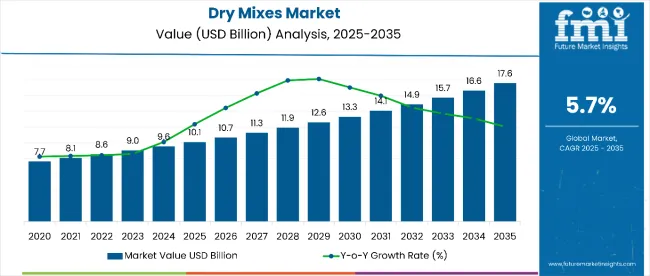
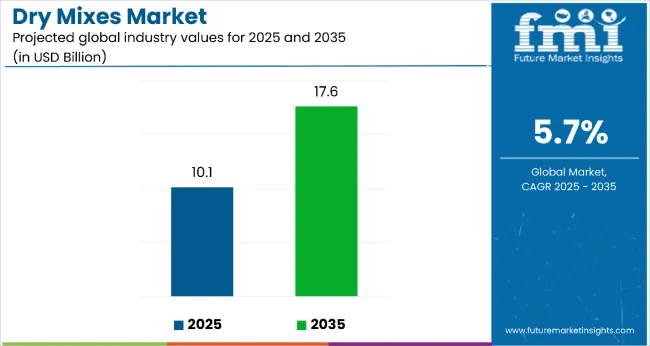
| Metric | Value |
|---|---|
| Market Value (2025E) | USD 10.1 billion |
| Market Forecast Value (2035F) | USD 17.6 billion |
| Forecast CAGR (2025 to 2035) | 5.7% |
This expansion represents an absolute dollar opportunity of USD 7.5 billion. By 2030, the market is expected to reach USD 13.4 billion, contributing USD 3.3 billion in incremental value in the first half of the period, followed by an additional USD 4.2 billion by 2035. This balanced growth trajectory reflects steady demand from both developed and emerging markets, driven by increased urbanization, fast-paced lifestyles, and a growing appetite for shelf-stable, easy-to-prepare food products.
Rising demand for ready-to-eat meals, instant food solutions, and baking convenience is fueling market momentum. The expansion of quick-service restaurants (QSRs), alongside a shift in household eating habits, has led to greater adoption of dry mixes in everyday cooking. These products are particularly favored for their long shelf life, nutritional value, and versatility across multiple cuisines. Dry mixes are also playing a growing role in the Bakery, Dairy, and Spice Mix categories, as consumers seek diverse flavors and health-conscious alternatives that fit into their busy routines.
Leading companies such as General Mills, Nestlé, Unilever, and Midas Foods are reinforcing their positions through innovation in formulations, investment in product development, and expansion into emerging regions. General Mills is expected to hold a 20% market share in 2025. These firms are focusing on enhanced nutrition, sustainable packaging, and distribution channels to tap into the evolving demands of health-conscious consumers.
The market holds a strong position across various food industry segments, driven by its versatility, convenience, and compatibility with modern consumption habits. In 2025, Different Dry Grain Blend Mixes lead the product category with a 30% share, while the HoReCa segment dominates end use at 35%, reflecting growing demand from commercial kitchens and food service outlets. Geographically, India, China, and the USA are top contributors, with India accounting for 6.8% of the global market.
Increasing urbanization, fast-paced lifestyles, and rising demand for ready-to-eat and instant food solutions support market expansion. Innovations in formulation, flavor blending, and packaging have allowed manufacturers to launch value-added, functional dry mixes tailored for health-conscious and time-sensitive consumers. The market is seeing a shift toward premium, fortified, and clean-label products as companies like General Mills (20% market share), Nestlé, Unilever, and Midas Foods invest in R&D and product innovation.
The market is experiencing significant growth due to rising consumer demand for convenient, time-saving food solutions that maintain taste and nutritional value. Dry mixes offer a long shelf life, easy preparation, and versatility across multiple cuisines, making them especially attractive to modern urban consumers and food service providers.
Growing urbanization, busy lifestyles, and rising disposable incomes, especially in emerging economies like India and China, are key drivers of market expansion. Additionally, the trend toward clean-label, preservative-free products is pushing manufacturers to innovate with natural ingredients and functional blends. Consumers are also gravitating toward dry mixes for their cost-efficiency, minimal waste, and suitability for bulk preparation, particularly in commercial kitchens and institutional catering.
As awareness increases around global cuisines, nutrient-rich cooking, and shelf-stable food formats, demand for dry mixes in bakery, dairy, and spice categories is growing rapidly. With ongoing product innovation, improvements in packaging, and strategic partnerships by leading players such as General Mills, Nestlé, and Unilever, the market is well-positioned for sustained growth.
The market is segmented by product type, end user, distribution channel, and region. By product type, the market is classified into different dry grain blend mixes, dry spice mixes, dry baking mixes, dry curry seasoning mixes, and other dry mixes. Based on end user, the market is divided into HoReCa, bakery and dairy, and households. In terms of distribution channel, the market is bifurcated into direct sales and indirect sales. Regionally, the market is characterized into North America, Latin America, Western Europe, Eastern Europe, South Asia and Pacific, East Asia, and the Middle East & Africa.
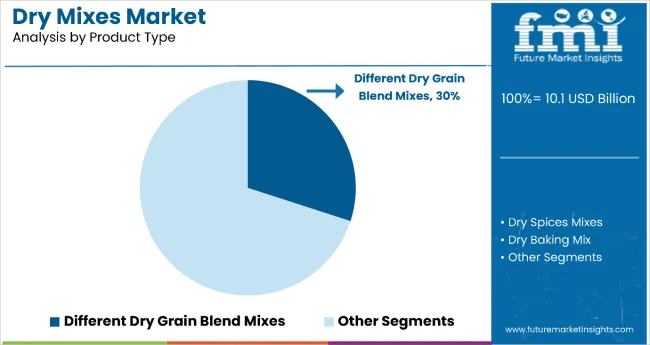
The different dry grain blend mixes segment leads the market with a 30% share in 2025, driven by rising demand for nutrient-dense, convenient meal solutions aligned with global health and wellness trends. These blends often combine whole grains such as quinoa, millet, oats, lentils, and brown rice, valued for their high fiber, protein, and mineral content. As consumers increasingly adopt plant-based diets and functional foods, grain blends present a strong alternative to refined carbohydrate staples.
The segment also benefits from the growth of health-focused meal kits, vegan bowls, and ready-to-cook products in both retail and HoReCa channels. Manufacturers are investing in innovative flavor combinations and pre-seasoned blends designed for time-pressed urban consumers seeking quick yet healthy options. With advancements in packaging, organic sourcing, and clean-label certification, different dry grain blend mixes are well-positioned for sustained growth across diverse global markets.
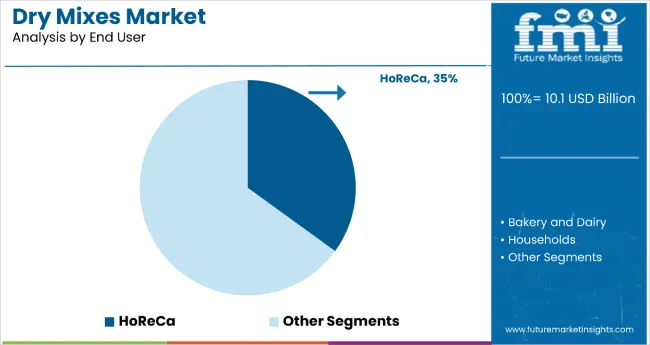
The HoReCa segment dominates the dry mixes market with a 35% share in 2025, fueled by the rapid expansion of foodservice chains, quick-service restaurants (QSRs), and institutional kitchens that prioritize consistency, long shelf life, and operational efficiency. Dry mixes enable standardized flavor profiles, reduced preparation time, and minimal waste, key advantages for commercial kitchens focused on speed and scalability.
The rebound in global tourism and the resurgence of dining-out culture post-pandemic have further amplified demand for versatile dry mix solutions in sauces, batters, seasonings, and baked goods. Additionally, innovations in clean-label formulations and specialty diet mixes, including gluten-free and vegan options, are enhancing the segment’s appeal. These factors firmly position HoReCa as a key growth driver in the dry mixes market through 2035.
From 2025 to 2035, the market is primarily driven by the rising demand for convenient, shelf-stable meal solutions among urban consumers and foodservice operators. With rapid urbanization, dual-income households, and evolving culinary habits, consumers are increasingly seeking ready-to-cook formats that reduce preparation time while delivering consistent taste and quality.
Consumer Perception of Dry Mixes as Processed Products Limits Premium Segment Growth
Despite strong market growth, the market faces several key restraints. One major challenge is the consumer perception that dry mixes are overly processed or lack freshness, which can deter health-conscious buyers. In emerging markets, price sensitivity remains a significant barrier, limiting the adoption of premium dry mix products. Additionally, rural areas continue to favor traditional cooking practices, hindering market penetration. Variability in ingredient quality, especially in spice and seasoning blends, affects product reliability and brand trust. Some consumers also express concerns over artificial additives or preservatives in dry mixes.
Technological Innovations in Freeze-Drying and Nutrient Fortification Enhance Product Appeal
One of the most defining trends is the premiumization of dry mixes, with manufacturers offering organic, gluten-free, vegan, and ethnic flavor variants to cater to health-focused and culturally diverse consumers. Another emerging trend is the development of single-serve and on-the-go sachets, especially targeting the travel, aviation, and hostel food markets. Innovations in freeze-drying, flavor encapsulation, and fortification are also enhancing functionality and appeal, positioning dry mixes not just as time-savers, but as nutrient-rich culinary solutions.
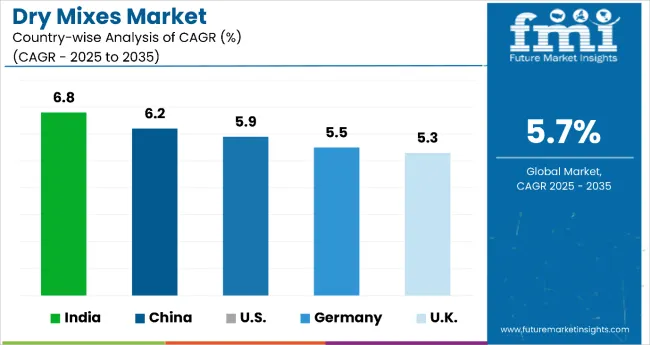
| Countries | CAGR |
|---|---|
| India | 6.8% |
| China | 6.2% |
| USA | 5.9% |
| Germany | 5.5% |
| UK | 5.3% |
India leads with the highest projected CAGR of 6.8%, driven by urbanization, dual-income households, and rising demand for quick-prep meals. China follows closely at 6.2%, leveraging its strong food processing capabilities and widespread consumer base. The USA, with a mature market, shows a solid 5.9% CAGR, fueled by health-conscious consumers seeking clean-label and functional products. Germany maintains steady growth at 5.5%, with demand rooted in its baking traditions and preference for natural ingredients. The UK posts a 5.3% CAGR, supported by growing interest in global cuisines and health-oriented dry mixes.
The report covers an in-depth analysis of 40+ countries; five top-performing OECD countries are highlighted below.
Sales of dry mixes in India are projected to grow at a CAGR of 6.8%, driven by urbanization, growing middle-class consumption, and evolving food preferences. The demand for ready-to-cook meals has surged due to dual-income households and fast-paced urban lifestyles. Traditional spice blends and baking mixes are now being repackaged as premium dry mix solutions for both HoReCa and home kitchens. Major domestic food brands are capitalizing on regional flavor profiles and health-conscious product development. The e-commerce boom and aggressive marketing by FMCG giants are rapidly expanding accessibility. Additionally, government support for food processing industries is accelerating the development of standardized, shelf-stable mixes. Young consumers are especially inclined toward fusion foods and global cuisines, boosting the variety of available mixes.
Dry mixes revenue in China is growing at a CAGR of 6.2%, supported by its advanced food processing infrastructure and high-volume domestic consumption. Increasing disposable incomes and urbanization have fostered demand for convenience food. The Chinese population is increasingly adopting Western cuisines, which fuels the popularity of baking and seasoning mixes. Additionally, China’s manufacturing scale allows efficient mass production and nationwide distribution. Domestic companies are focusing on quality and product variety to meet diverse consumer tastes, while international brands are localizing offerings to suit regional palettes. The government’s emphasis on food innovation and food safety regulations is also aiding the premiumization of dry mix offerings.
The USA dry mixes revenue is expanding at a CAGR of 5.9%, benefits from a mature yet innovation-driven landscape. Consumers are increasingly seeking health-oriented, clean-label, and time-saving cooking solutions. The market is well-established for baking, spice, and seasoning mixes, particularly in retail and HoReCa segments. Gluten-free, low-sodium, and organic product variants are gaining strong momentum, especially among millennials and health-conscious individuals. Functional dry mixes with added nutrients or plant-based ingredients are also gaining appeal. Innovations in ethnic and global cuisines continue to influence flavor variety and product development.
Sales of dry mixes in Germany are experiencing steady growth, with a CAGR of 5.5%, reflecting its strong culinary traditions and preference for premium quality. German consumers prioritize clean-label, non-GMO, and preservative-free products, which aligns well with the evolving dry mix offerings. Demand is particularly robust for baking and bread mixes, given the country’s deep-rooted baking culture. The market is also influenced by increasing interest in global flavors, driving uptake of spice and curry seasoning blends. Both HoReCa and households are contributing to market growth as convenience and health trends overlap. Additionally, the country's focus on sustainability is leading manufacturers to adopt eco-friendly packaging and ethical sourcing.
The UK dry mixes revenue is anticipated to grow at a 5.3% CAGR, driven by evolving consumer preferences toward convenient yet gourmet-quality food. The rise of work-from-home culture has increased at-home cooking, boosting demand for easy-prep meal solutions such as baking mixes, spice blends, and seasoning kits. British consumers are keen on experimenting with world cuisines, creating opportunities for ethnic and regional dry mixes. The market is also benefitting from the growing health and wellness trend, with strong demand for low-fat, low-sugar, and low-sodium variants. Clean-label packaging and transparency in ingredient sourcing are gaining consumer trust.
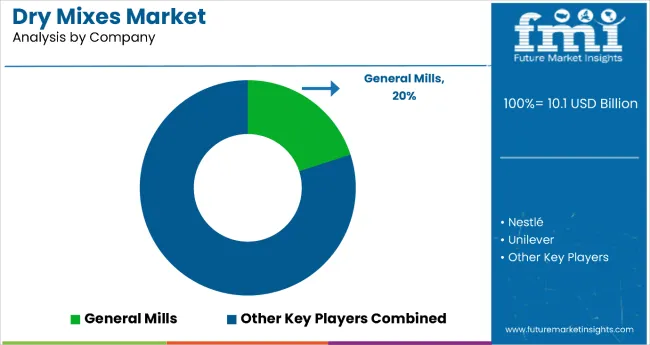
The market is moderately fragmented, with leading dominance from companies leveraging vertical integration, strong distribution networks, and a diversified product portfolio. As of 2025, Nestlé S.A. holds the top market position, driven by its well-established culinary brands, global presence, and strategic focus on health-oriented dry mix formulations.
Leading player status is held by Nestlé S.A. Other prominent players in the market include General Mills Inc., The Kraft Heinz Company, McCormick & Company Inc., Unilever PLC, Associated British Foods PLC, Dr. Oetker, Ajinomoto Co. Inc., Conagra Brands Inc., and Goya Foods Inc. These companies offer an extensive range of dry products such as baking mixes, seasoning blends, grain-based mixes, and ethnic spice kits.
New entrants are targeting niche categories like plant-based, gluten-free, or organic dry mixes, primarily through D2C platforms and health-focused product innovations. However, larger players continue to benefit from brand loyalty, economies of scale, and widespread retail penetration.
| Item | Value |
|---|---|
| Quantitative Units | USD 10.1 Billion |
| Product Type | Different Dry Grain Blend Mixes, Dry Spices Mixes, Dry Baking Mix, Dry Curry Seasoning Mix, Other Dry Mixes |
| End User | HoReCa, Bakery and Dairy, Households |
| Distribution Channel | Direct Sales, Indirect Sales |
| Regions Covered | North America, Europe, Asia-Pacific, Latin America, Middle East & Africa |
| Countries Covered | United States, Canada, United Kingdom, Germany, France, China, Japan, South Korea, Brazil, Australia and 40+ countries |
| Key Companies Profiled | The Linde Group, Midas Foods International, National Food Group, Inc., Wendels True Foods, Custom Cafe Foods, Brady Enterprises, Inc., Unilever Food Solutions, Nestlé S.A., Centre State Food Service, Davis Food Co-op |
| Additional Attributes | Market share by product type and end-use application; rising demand from HoReCa and households; evolving taste preferences; innovation in regional spice and seasoning blends; expansion in ready-to-cook meal solutions |
The global dry mixes market is estimated to be valued at USD 10.1 billion in 2025.
The market size for the dry mixes market is projected to reach USD 17.6 billion by 2035.
The dry mixes market is expected to grow at a 5.7% CAGR between 2025 and 2035.
Different dry grain blend mixes are projected to lead in the dry mixes market with a 30% market share in 2025.
In terms of end use, the HoReCa segment is expected to command a 35% share in the dry mixes market in 2025.






Our Research Products

The "Full Research Suite" delivers actionable market intel, deep dives on markets or technologies, so clients act faster, cut risk, and unlock growth.

The Leaderboard benchmarks and ranks top vendors, classifying them as Established Leaders, Leading Challengers, or Disruptors & Challengers.

Locates where complements amplify value and substitutes erode it, forecasting net impact by horizon

We deliver granular, decision-grade intel: market sizing, 5-year forecasts, pricing, adoption, usage, revenue, and operational KPIs—plus competitor tracking, regulation, and value chains—across 60 countries broadly.

Spot the shifts before they hit your P&L. We track inflection points, adoption curves, pricing moves, and ecosystem plays to show where demand is heading, why it is changing, and what to do next across high-growth markets and disruptive tech

Real-time reads of user behavior. We track shifting priorities, perceptions of today’s and next-gen services, and provider experience, then pace how fast tech moves from trial to adoption, blending buyer, consumer, and channel inputs with social signals (#WhySwitch, #UX).

Partner with our analyst team to build a custom report designed around your business priorities. From analysing market trends to assessing competitors or crafting bespoke datasets, we tailor insights to your needs.
Supplier Intelligence
Discovery & Profiling
Capacity & Footprint
Performance & Risk
Compliance & Governance
Commercial Readiness
Who Supplies Whom
Scorecards & Shortlists
Playbooks & Docs
Category Intelligence
Definition & Scope
Demand & Use Cases
Cost Drivers
Market Structure
Supply Chain Map
Trade & Policy
Operating Norms
Deliverables
Buyer Intelligence
Account Basics
Spend & Scope
Procurement Model
Vendor Requirements
Terms & Policies
Entry Strategy
Pain Points & Triggers
Outputs
Pricing Analysis
Benchmarks
Trends
Should-Cost
Indexation
Landed Cost
Commercial Terms
Deliverables
Brand Analysis
Positioning & Value Prop
Share & Presence
Customer Evidence
Go-to-Market
Digital & Reputation
Compliance & Trust
KPIs & Gaps
Outputs
Full Research Suite comprises of:
Market outlook & trends analysis
Interviews & case studies
Strategic recommendations
Vendor profiles & capabilities analysis
5-year forecasts
8 regions and 60+ country-level data splits
Market segment data splits
12 months of continuous data updates
DELIVERED AS:
PDF EXCEL ONLINE
Dry-type Air-core Smoothing Reactor Market Size and Share Forecast Outlook 2025 to 2035
Dry Powder Inhaler Market Size and Share Forecast Outlook 2025 to 2035
Dry Vacuum Pumps Market Size and Share Forecast Outlook 2025 to 2035
Dry Cleaning Solvents Market Size and Share Forecast Outlook 2025 to 2035
Dry Block Heaters Market Size and Share Forecast Outlook 2025 to 2035
Dry Fog Dust Suppression Equipment Market Size and Share Forecast Outlook 2025 to 2035
Dry Scalp Treatment Market Size and Share Forecast Outlook 2025 to 2035
Dry Type Distribution Transformer Market Size and Share Forecast Outlook 2025 to 2035
Dry Type Current Transformer Market Size and Share Forecast Outlook 2025 to 2035
Dry Eye Syndrome Treatment Market Size and Share Forecast Outlook 2025 to 2035
Dry Type Automated Solar Panel Cleaning Market Size and Share Forecast Outlook 2025 to 2035
Dry Electrostatic Precipitator Market Size and Share Forecast Outlook 2025 to 2035
Dry Herb Cannabis Vaporizers Market Size and Share Forecast Outlook 2025 to 2035
Dry Type Transformer Market Size and Share Forecast Outlook 2025 to 2035
Dry Whole Milk Powder Market Size and Share Forecast Outlook 2025 to 2035
Dry Gas Coupling Market Analysis Size and Share Forecast Outlook 2025 to 2035
Dryer Sheets Market Size and Share Forecast Outlook 2025 to 2035
Dry Electrostatic Wipes Market Size and Share Forecast Outlook 2025 to 2035
Drylab Photo Printing Market Size and Share Forecast Outlook 2025 to 2035
Dry and Wet Wipes Market Size and Share Forecast Outlook 2025 to 2035

Thank you!
You will receive an email from our Business Development Manager. Please be sure to check your SPAM/JUNK folder too.
Chat With
MaRIA